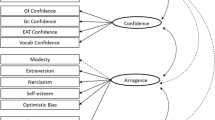Abstract
The self-appraisal model of Type A behavior holds that Type A's desire an accurate appraisal of abilities, and respond to uncertainty about abilities with exaggerated attempts to generate diagnostic information. The model also predicts that the major emotional response to uncertainty for Type A's is anxiety. In this study, Type A's and B's were induced to succeed or fail on a task where they were either very certain or very uncertain of their subsequent ability levels. Task failure produced greater depression, anger, and frustration for all subjects. Consistent with the self-appraisal model's prediction, uncertainty (regardless of success or failure) led to greater anxiety for Type A's than for Type B's. In fact, greater uncertainty produced lower anxiety for Type B's, indicating that Type A's and B's differ dramatically in their emotional responses to uncertainty about abilities.
Similar content being viewed by others
References
Dembroski, T. M., & Costa, P. T., Jr. (1987). Coronary prone behavior: Components of the Type A pattern and hostility.Journal of Personality, 55 211–235.
Dembroski, T. M., Weiss, S. M., Shields, J. Haynes, S., & Feinleib, M. (Eds.). (1978).Coronary-prone behavior. New York: Springer-Verlag.
Francis, K. T. (1981). Perceptions of anxiety, hostility, and depression in subjects exhibiting the coronary-prone behavior pattern.Journal of Psychiatric Research, 16 183–190.
Garber, J., Miller, S. M., & Abramson, L. Y. (1980). On the distinction between anxiety and depression: Perceived control, certainty, and probability of goal attainment. In J. Garber & M. E. P. Seligman (Eds.),Human helplessness: Theory and applications (pp. 131–169). New York: Academic Press.
Gastorf, J. W., & Teevan, R. C. (1980). Type A coronary-prone behavior pattern and fear of failure.Motivation and Emotion, 4 71–76.
Glass, D. C. (1977).Behavior patterns, stress, and coronary disease. Hillsdale, NJ: Erlbaum.
Glass, D. C., & Carver, C. S. (1980). Helplessness and coronary-prone personality. In J. Garber & M. E. P. Seligman (Eds.),Human helplessness: Theory and applications (pp. 223–243). New York: Academic Press.
Krantz, D. S., Glass, D. C., Schaeffer, M. A., & Davia, J. E. (1982). Behavior patterns and coronary disease: A critical evaluation. In J. T. Cacioppo & R. E. Petty (Eds.),Focus on cardiovascular psychophysiology (pp. 315–346). New York: Guilford Press.
Krantz, D. S., Glass, D. C., & Snyder, M. L. (1974). Helplessness, stress level, and the coronary-prone behavior pattern.Journal of Experimental Social Psychology, 10 284–300.
Lazarus, R. S. (1966).Psychological stress and the coping process. New York: McGraw-Hill.
Lazarus, R. S., & Averill, J. R. (1972). Emotion and cognition: With special reference to anxiety. In C. D. Spielberger (Ed.),Anxiety: Current trends in theory and research. New York: Academic Press.
Lazarus, R. S., Averill, J. R., & Opton, E. M. (1970). Towards a cognitive theory of emotion. In M. Arnold (Ed.),Third international symposium of feelings and emotions. New York: Academic Press.
Lazarus, R. S., & Opton, E. M. (1966). The study of psychological stress: A summary of theoretical formulations and experimental findings. In C. D. Spielberger (Ed.),Anxiety and behavior. New York: Academic Press.
Matthews, K. A. (1982). Psychological perspectives on the Type A behavior pattern.Psychological Bulletin, 91 293–323.
Matthews, K. A., & Haynes, S. G. (1986). Type A behavior pattern and coronary disease risk: Update and critical evaluation.American Journal of Epidemiology, 123 923–960.
Matthews, K. A., & Siegel, J. M. (1982). Type A behavior pattern in children and adolescents. In A. Baum & J. E. Singer (Eds.),Handbook of psychology and health (Vol 2). Hillsdale, NJ: Erlbaum.
Peterson, C., Semmel, A., Metalsky, G., Abramson, L. Y., von Baeyer, C., & Seligman, M. E. P. (1982). The Attributional Style Questionnaire.Cognitive Therapy and Research, 6 287–299.
Review Panel on Coronary-Prone Behavior and Coronary Heart Disease. (1981). Coronary-prone behavior and coronary heart disease: A critical review.Circulation, 63 1199–1215.
Schulz, P., & Schönpflug, W. (1982). Regulatory activity during states of stress. In H. W. Krohne & L. Laux (Eds.),Achievement, stress, and anxiety (pp. 51–73). Washington, DC: Hemisphere.
Smith, T. W., Houston, B. K., & Zurawski, R. M. (1983). The Framingham Type A scale and anxiety, irrational beliefs, and self-control.Journal of Human Stress, 9 32–37.
Spielberger, C. D. (1972). Anxiety as an emotional state. In C. D. Spielberger (Ed.),Anxiety: Current trends in theory and research (pp. 23–49). New York: Academic Press.
Spielberger, C. D. (1979).Understanding stress and anxiety. New York: Harper & Row.
Strube, M. J. (1987). A self-appraisal model of the Type A behavior pattern. in R. Hogan & W. H. Jones (Eds.),Perspectives in personality (Vol. 2, pp. 201–250). Greenwich, CT: JAI Press.
Strube, M. J., & Boland, S. M. (1986). Post-performance attributions and task persistence among Type A and B individuals: A clarification.Journal of Personality and Social Psychology, 50 413–420.
Strube, M. J., Boland, S. M., Manfredo, P. A., & Al-Falaij, A. (1987). Type A behavior and the self-evaluation of abilities: Empirical tests of the self-appraisal model.Journal of Personality and Social Psychology, 52 956–974.
Trope, Y. (1982). Self-assessment and task performance.Journal of Experimental Social Psychology, 18 201–215.
Trope, Y., Ben-Yair, E. (1982). Task construction and persistence as means for self-assessment of abilities.Journal of Personality and Social Psychology, 42 637–645.
Yarnold, P. R., Mueser, K. T., Grau, B. W., & Grimm, L. G. (1986). The reliability of the student version of the Jenkins Activity Survey.Journal of Behavioral Medicine, 9 401–414.
Author information
Authors and Affiliations
Rights and permissions
About this article
Cite this article
Shalon, M., Strube, M.J. Type A behavior and emotional responses to uncertainty: A test of the self-appraisal model. Motiv Emot 12, 385–398 (1988). https://doi.org/10.1007/BF00992361
Issue Date:
DOI: https://doi.org/10.1007/BF00992361




